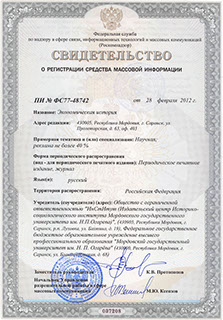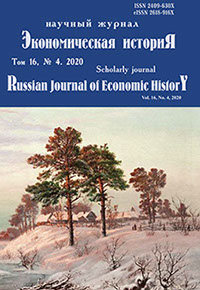Экономическая историЯ
Russian Journal of Economic History
ISSN 2409-630X (Print)
ISSN 2618-916X (Online)
Expert board:
- Scientific Council of RAS on economic history;
- Research and Educational Center «The economic history of Central Russia and the Middle Volga region» of Ogarev Mordovia State University;
- Center of Economic History of Lomonosov Moscow State University
Navigation
Certificate of registration

Georgy N. Shumkin
Institute of History and Archeology of the Ural branch of the Russian Academy of Sciences (Yekaterinburg, Russia), e-mail: shumk@mail.ru
Equal Release Vector as a Method of Studying Industrialization (based on the materials of the Russian iron ore industry of the late 19th – early 20th centuries)
Introduction. In modern historiography industrialization is defined as the process of replacing labor with machine technology, but in applied research, machine technology for workers acts not as a substitute, but as a complementary good that increases labor productivity. This contradiction between the definition and research results is due to the limitations of the methods used. Materials and Methods. As a tool to overcome these limitations, the author of this paper suggests using the equal release vector method, developed by him on the basis of the well-known model of the isoquant and producer equilibrium in economic theory. The purpose of this work is to test the heuristic potential of this method on the material of the iron ore industry of the Urals, Poland and Southern Russia in the late 19th – early 20th centuries. Results. The study found that the equal release vector gives a clear idea of the periods when resources replace and complement each other, and also revealed the advantages and disadvantages of the equal release vector method. Its advantages include the fact that it provides a visual representation of changes in the amount of resources per unit of output, is easy to learn, and can be used to analyze technological transformations of both an individual enterprise and the entire industry. Its disadvantages include high sensitivity to the quality of the source and completeness of data. This method should only be used as an addition to the traditional analysis of absolute and average indicators. It allows you to analyze the interaction of only two resources.
Keywords: methodology, industrialization, labor, capital, isoquant, equal release vector, iron ore mining, Ural, Poland, South of Russia.
For citation: Shumkin G. N. Equal release vector as a method of studying industrialization (based on the materials of the Russian iron ore industry of the late 19th – early 20th centuries). Ekonomicheskaya istoriya = Russian Journal of Economic History. 2020; 16(4): 361–374. (In Russ.). DOI: 10.15507/2409-630X.051.016.202004.361-374.
© Ogarev Mordovia State University. History and Sociology Institute, 2017
68, Of. 411, Bolshevistskaya St., 430005, The editorial office of the scholarly journal «Russian Journal of Economic History»
Tel.: (8342) 24-25-90; 27-07-11, Fax: (8342) 24-25-90, E-mail: jurnal-econom-hist@isi.mrsu.ru
Designed by A. Napalkov, Email: napalkov@isi.mrsu.ru

